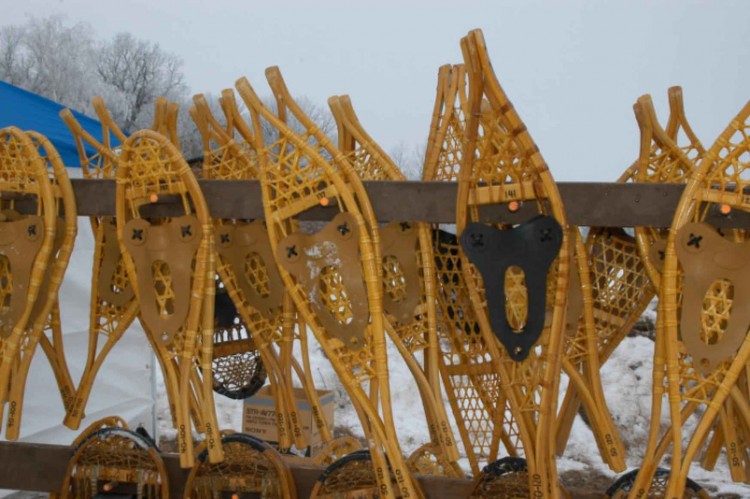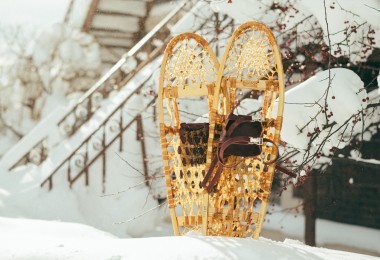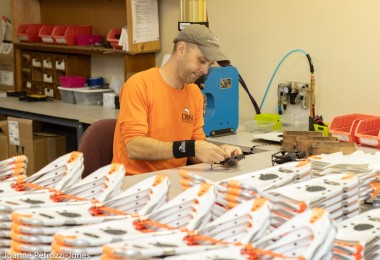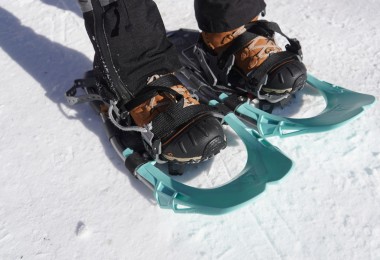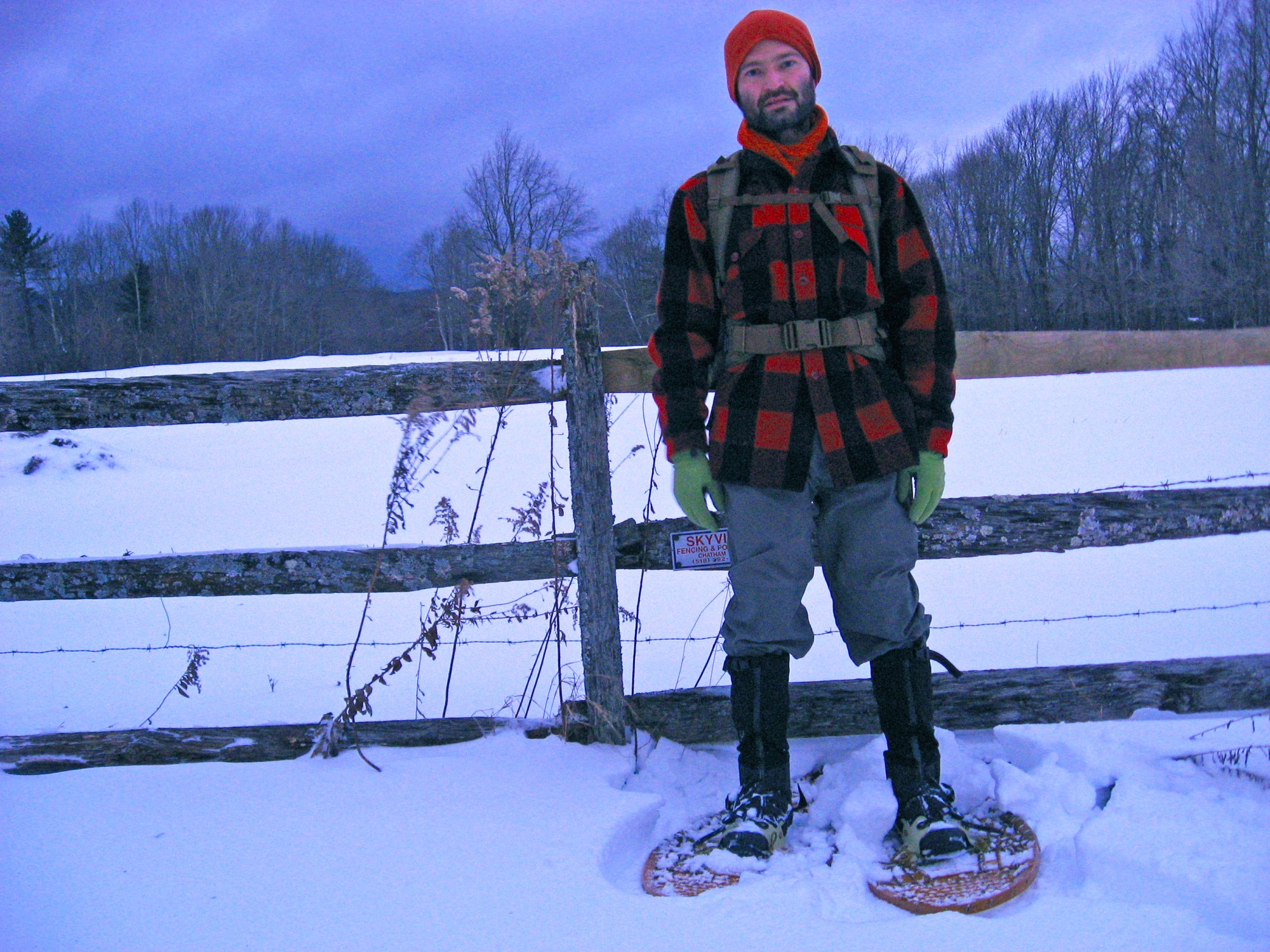Once, I was at a friend’s cottage and had the run of the place, alone for a couple of days of “R and R.” I had brought my traditional snowshoes (and bindings) along, hoping to head out and take advantage of the scenery. Hopefully, I could do some wildlife tracking and take some photos, as there were rumors of a lynx prowling about the area.
I dressed, gathered my things, and was all set to go when what could have been tragedy struck. The binding on one of my traditional-style snowshoes snapped. I’d been using the same bindings (leather strap and buckle “A”-style bindings) on this particular pair of snowshoes (a huge pair of Hurons) for as long as I can remember without incident.
Looking back, the scene was quite humorous – as I pulled to tighten the leather binding, the leather strap gave way, and I tumbled backward into the snow. I had one shoe on, one shoe off, leather strap in hand, and wound up in three feet of snow with my feet in the air.
Fortunately, I had more than one pair of snowshoes with me and could change the bindings. After dusting myself off, I could still head out into the snow. I didn’t get any Lynx shots, just tracks, but it was still a great outing. However, this would have been the end of the road for many snowshoers until they could use their snowshoe repair kit or get new bindings.
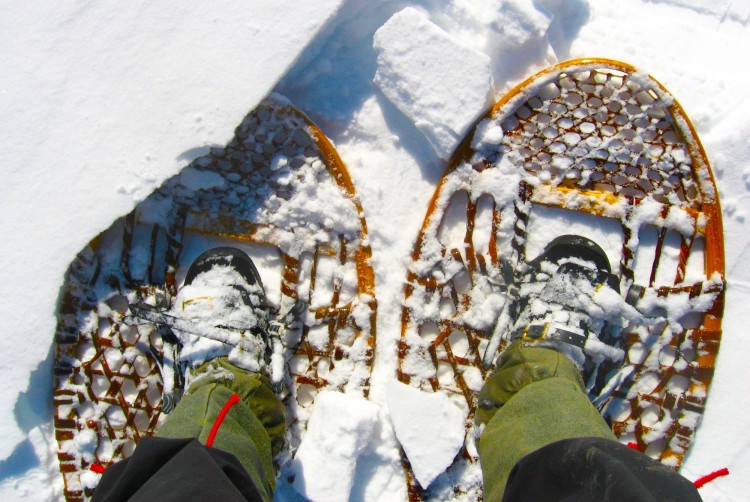
Bindings are an essential part of the snowshoe but are often not considered. Photo: Unsplash / Aaron Huber
Importance of Snowshoe Bindings
Traditional and modern snowshoe bindings are a critical but often forgotten accessory. Even though I’ve got four styles of bindings to go with the four pairs of traditional snowshoes I own, I never really paid much attention to them.
All was well as long as they kept the snowshoes on my feet. I never considered their functionality or gave them much more than the basic maintenance that the different styles required.
But having a binding snap got me thinking about bindings in a whole new light. Without bindings, snowshoes are nothing more than funny-shaped tennis racquets with a big hole in the middle. They’re about as useful in the snow as speech therapy is to a mime.
Read More: The Systems That Bind: An Overview of Snowshoe Bindings
Different Traditional Binding Styles
My introduction to snowshoes came as a teenager in the mid-80s. I was instantly hooked and asked for a pair of my own for Christmas. I still have that first pair, a gorgeous pair of Hurons (and, until recently, the bindings).
As I learned over the years, there are as many different binding styles for traditional snowshoes as there are snowshoes themselves (probably more). In this article, we’ll focus on common bindings.
A- Style Binding
“A”-style bindings have a criss-cross pattern across the foot with a strap around the back.
Pros
My pair consisted of a thick leather toe piece buckled over both sides of the boot onto the snowshoes. A strap wound around the back of the foot and buckled in place, which was the offending piece that snapped recently. Before the snapping, I’ve had these leather bindings for years.
I also have an “A” style binding with a nylon strap. A plastic clip and drawstring lace together to tighten the leather toe piece. “A” style bindings typically adjust easily and are easy to put on and off with various boots. I’ve had these bindings for a couple of years now.
Drawbacks
The drawback of using a leather strap with buckles is that when wet, the leather tends to stretch, allowing the wearer’s foot to come loose from the snowshoe. It can be such a pain to have to stop every 15 minutes to retighten the strap.
An “A” binding may not allow as much up and down movement as other bindings, such as the “H” style described below.
Of the two “A” styles, I prefer the nylon A-style to the leather version. Doing up the buckles on the leather pair at –30 degrees Celsius is never a treat. On the other hand, the plastic clip on the nylon version is more straightforward and quicker to do. The nylon strap is also an improvement, as it doesn’t stretch and come loose.
A-Style Options
Iverson Outdoors: A Binding and AA Binding
Country Ways: Super A Binding
Read More: Traditional Wooden Snowshoes: Shapes, Designs, Names
H-Style Binding
The “H” style binding has a strap crossing the boot, along with a toe and heel strap. The one I have the most experience with consists of a leather toe strap and a leather strap that wraps around the boot. However, similar to the “A” style, the “H” strap can also be made with nylon or neoprene.
Pros
An “H” style neoprene binding provides a very stable connection and typically more movement of the boot. It also caters to a variety of different boot sizes.
Drawbacks
Of the four bindings that I’ve used, this is the one that has generally given me the most grief – the leather heel strap frequently comes loose in warmer weather. The nylon or neoprene strap, however, may present a stronger option that, as opposed to leather, won’t stretch with changing conditions.
Also, “H” style bindings can be difficult to adjust and require more work to put on than most “A” style bindings. When I compare the “H” to the “A” style and lamp wick bindings mentioned here, it is the most troublesome for me.
H-Style Options
Iverson Outdoors: H Binding and XL H Binding
GV Snowshoes: Traditional Leather Bindings
Country Ways: Leather Modified H, Neoprene Modified H, and XL Neoprene Modified H
Maine Guide Snowshoes: Master Guide Binding
Read More: A Few U.S Artisans Keep Traditional Snowshoes a Tradition
Lamp Wick Binding
The first snowshoe binding was simply a softened piece of leather. It was wound around in figure eight to secure the wearer’s moccasins to their snowshoes. Eventually, lamp wick was used in this manner. I’ve got an old pair of Huron-style snowshoes with a lamp wick for bindings.
Pros
Once tied, you can simply slip your foot in and out, a huge plus if you lose your balance in deep snow (no buckles or straps to fiddle with). For traditionalists, this is the way to go. This binding is also relatively inexpensive.
Drawbacks
It took a while to master the technique of tying my lamp wick bindings. Explaining how they are tied just isn’t the same as seeing it. Lure of the North offers a helpful video highlighting the technique.
This style of binding tends to work best with a moccasin or high boot. With a low-cut boot, it can slip up over the boot if not tied perfectly, causing your snowshoe to come loose.
Lampwick Options
Country Ways: Lampwick Binding
Read More: A Historical Perspective of Snowshoes
Rubber Bindings
Rubber bindings do not include straps and are mounted to the snowshoe.
Pros
The flexible material fits a wide range of boot styles and sizes. They also are easy to slip in and out of when fastening your snowshoe.
Drawbacks
Rubber bindings may not provide the support and range of movement compared to “A” or “H” bindings.
Rubber Binding Options
GV Snowshoes: Large Rubber Bindings, X-Large Rubber Bindings
Rachet Bindings
Rachet bindings are more commonly used on ski boots. Many snowshoes, including traditional snowshoes, used ratchet bindings as they provided stability and were easy to slip on and adjust. However, as bindings developed, rachet bindings were replaced with lighter-weight options.
Read More: Make Your Own Snowshoes from Scratch
Traditional Snowshoe Binding Maintenance
Just a quick word on binding maintenance – if your bindings are leather, they require treating them with a water-repellant leather preservative. It’s also a good idea to keep any metal buckles lubricated. I like a silicon-based lubricant for this.
As with snowshoes, bindings are a personal preference. For me, a modified “A”-style binding works well. But the best advice I can give you is to try out several styles and see what works.
Read Next: How To Care for Wood-Framed Snowshoes
This article was first published on March 22, 2005, and was most recently updated on January 11, 2024.

